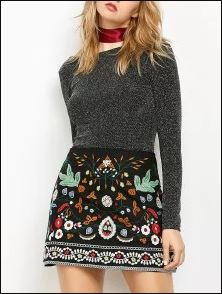More Than Just a Grandma Hobby
- Melissa Galbraith
- Aug 22, 2018
- 2 min read
Updated: Oct 19, 2020
If you know me, then you know I constantly carry around a small bag full of embroidery projects. Needle and thread have become a passion of mine. Many people think of embroidery as something their grandmas used to do, but with the resurgence of millennials wanting to work and craft with their hands, it's becoming more popular and dare I say, even trendy.
How old is this art form?
Embroidery is the handcrafted art of embellishing fabric with a thread and needle. It's origins date back as far as 30,000 BC and has been used to decorate the clothing and housewares from religious figureheads to royalty. It was considered a symbol of luxury and wealth due to the fine materials (gold and silver thread) and labor intensive act of creating each decorative piece.
Free hand embroidery, as hand embroidery became known due to the rise of machine embroidery in Switzerland is the later half of the 19th century, has endured throughout the years because much like oral histories, the stitches have been passed down from generation to generation. From Vietnam to Mexico to Eastern Europe, each region has its own distinctive style of embroidery stitches and way of embellishment.

Embroidery became so popular in medieval England, that guilds and workshops known as Opus Anglicanum or "English work" were created to keep up with the demand. These embroideries featured many religious depictions and were often crafted by male embroiderers— surprising since embroidery is often referred to as a woman's domestic hand craft. In fact, most historical embroidery works featured symbol depictions inspired by religion and superstition, such as the Sphinx, Dragon and The Tree of Life, or to underline the membership to a certain aristocratic family.
Thankfully embroidery has evolved, changing its purpose and meaning along the way.

So how did I got into embroidery?
My mom is the craftiest lady I know. When I was younger, probably elementary school age, she taught me how to embroider. I really didn't appreciate her painstaking patience and skill at the time, however, I am extremely thankful she taught me to embroider and so many other useful sewing skills.
A few years ago, I decided I wanted to work with my hands. For my day-job, I sit in front of a computer all day and it sort of felt like I wasn't doing a whole lot, so took up embroidery again.
Not your grandma's pillowcases and linens
The term embroidery often has people thinking royal dresses or crocheted tea towels their grandma's used to pull out for special occasions— yes, those are still a thing— but embroidery has become so much more than a specialty use item or historical dress. Embroidery as a textile art has seen a rebirth thanks to fiber artists who have breathed new life into this once opulent and religious art form.
From stitching on tennis rackets to car hoods, using the hoop as a frame to stitching beyond the hoop, to embroidery as a political statement, embroidery has seen a revitalization.
Not only has embroidery seen a renewed interest in art, but it has become a popular fashion statement this season.
Still think embroidery is just something your grandma makes and wears?











































Comments